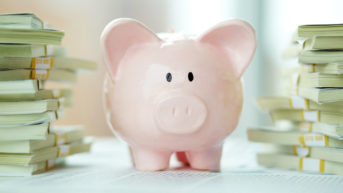The market is hard to please. Bank of Nova Scotia (TSX:BNS)(NYSE:BNS) had good quarterly results, but the stock responded by falling about 3.7% to below $77 per share on Tuesday.
The quality Canadian bank has been an excellent long-term investment. Should you buy on the dip? Before exploring whether the bank is a good buy today, let’s first take a look at its recent results.
Fiscal Q2 results
For the quarter, Scotiabank generated about half of its net income from its Canadian banking business, which saw strong loan growth of 7% (residential mortgages up 6% and business loans up 14%) and net interest margin expansion of five basis points to 2.43%. Its international banking business also did well, driven by strong growth from Pacific Alliance countries.
Here are some metrics compared to the same fiscal period in 2017:
| Q2 2017 | Q2 2018 | Change | |
| Revenue | $6,581 million | $7,058 million | 7.2% |
| Non-interest expenses | $3,601 million | $3,726 million | 3.5% |
| Net income | $2,061 million | $2,177 million | 0.7% |
| Diluted earnings per share | $1.62 | $1.70 | 4.9% |
| Return on equity | 14.9% | 14.9% | 0% |
| Adjusted net income | $2,075 million | $2,190 million | 5.5% |
| Adjusted diluted earnings per share | $1.63 | $1.71 | 4.9% |
| Interest income | $5,834 million | $6,735 million | 15.4% |
| Interest expense | $2,106 million | $2,785 million | 32.2% |
| Dividend per share | $0.76 | $0.82 | 7.9% |
| Payout ratio | 46.6% | 48% | 1.4% |
Scotiabank’s revenue increased 7.2%, while its non-interest expenses increased 3.5%. That’s pretty good. Although net income was flat, on a per-share basis, the bank’s earnings increased by almost 5%. Notably, Scotiabank maintained a decent return on equity of 14.9%.

Scotiabank offers a safe dividend
Scotiabank has paid dividends every year since 1832 and increased its dividend for 43 of the last 45 years.
The bank only froze its dividend in 2009 and again in 2010 as a safety measure against the financial crisis around that period. Other big Canadian banks also froze their dividends around the period. Back then, Scotiabank’s dividend was secure, as its payout ratio was about 50%.
Scotiabank’s most recent payout ratio was 48%. With expectations of higher profits and a payout ratio that aligns with its historical range, the bank should be able to grow its dividend at a healthy pace of 5-8% per year over the next few years.
Should you buy Scotiabank now?
At about $77 per share, Scotiabank trades at a reasonable price-to-earnings multiple of about 11.3, as the stock’s five-year normal multiple is about 11.7. At the recent quotation, Scotiabank is good for a yield of almost 4.3%.
The analyst consensus from Thomson Reuters Corp. has a 12-month target of about $91 per share on the stock, which represents near-term upside potential and total returns of about 18% and 22%, respectively.
Investors looking for a quality business at a fair price might consider Scotiabank for its +4% yield. Buyers today can expect long-term returns of at least 9%.








